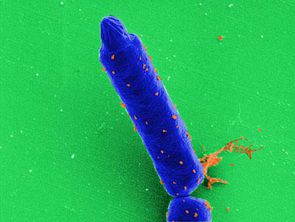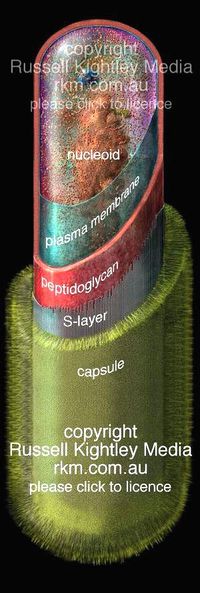Bacillus Anthracis NEU2011
Higher Order Taxa
Domain: Bacteria Phylum: Firmicutes Class: Bacilli Order: Bacillales Family: Bacillaceae Genus: Bacillus Species: Bacillus anthracis (Cohn 1872)
Description and significance
Bacillus Anthracis is a rod shaped bacteria with a width of 1-1.2 um and a length of 3-5 um. It can be grown in an ordinary nutrient broth, under either aerobic or anaerobic conditions. It was one of the first organisms to be proven to show disease, by Robert Koch. Bacillus Anthracis is similar in size, morphology, and spore formation with Bacillus cereus, and Bacillus thuringiensis.It is gram positive and is able to form spores. These spores are highly resistant and are able to sustain drastic changes in temperature, low nutrient environments, and application of harsh chemicals (including disinfectant chemicals such as 95% ethanol) over many years. Because the spores are so resilient, it is often hard to control this bacteria.
Bacillus Anthracis is pathogenic and is associated with the disease Anthrax. Anthrax is mostly obtained by livestock, such as cattle, goats and sheep. This is because the bacteria in the soil often form spores, which last for many years. Then an animal comes along, grazing on the grass where the spore is located and ingests the spore. Once in the body, the spore germinates and begins to grow and divide. Humans can obtain three different types of anthrax, intestional anthrax, cutaneous anthrax, and inhalation anthrax.
Genome Structure
There are currently 6 sequencing projects in progress and 5 complete genomes for the Bacillus anthracis bacteria. The complete genome sequence was first obtained using whole-genome shotgun sequencing. Bacillus anthracis has one chromosome and its genome is 5.5 Mb in size. The chromosome contains 5,227,419 base pairs. Its virulence factors are encoded on two plasmids, pXO1 (anthrax toxin, 181,677-bp) and pXO2 (capsule genes, 94,830-bp). (Ravel 445)
Ecology
Being part of the genus Bacillus, B.anthracis primarily inhabits slightly alkaline, calcium-rich soil and grow on decaying organic matter. Upon favorable conditions, it exists in its natural rod-shaped form. However, when the conditions become harsh, B.anthracis forms a spore using the calcium from the surrounding habitat for sporulation. This spore is rigid and is resistant to disinfectants, heat and drying. Because of this resistant spore, B.anthracis is an extremely harmful pathogen that causes anthrax and is extremely difficult to treat. It can remain dormant for years until the conditions are appropriate for growth and reproduction, such and in an animal where the bacteria can use the animal as a host. This essentially classifies the B.anthracis as parasitic.
The organism can be contracted via contact with soil that has colonies of the microbe inhabiting it, or in pools of water where B.anthracis in spore form may be found. The animals that are most prone to infection by B.anthracis are grazing herbivores such as sheep or cattle as well as other domesticated animals such as horses and mules. All warm-blooded animals are susceptible to infection due to the fact that B.anthracis grows optimally at a temperature of 30-39 degrees celsius, covering the body temperature range of all warm-blooded animals. Therefore, because cold-blooded animals do not sustain this temperature range, their risk of being invaded by B.anthracis is very low.
Cell Structure and Metabolism
Bacillus anthracis is a gram positive bacteria, indicating a very bulky cell wall which usually consists of the thick peptidoglycan layer, teichoic acids, lipoteichoic acids, capsulare polysacchrides, and crystalline cell surface proteins (often refered to as the S-layer proteins) which are often glycosylated. B. anthracis is different from this typical description of a gram positive bacteria. It’s capsule poly-γ-D-glutamate instead of the usual polysaccharide capsule, it’s S-layer are not glycosylated and finally, it does not contain any teichoic acids. These differences could be for many different reasons, for one, polysaccharides are associated with the adhesion of alpha defensins which are secreted by neutrophils to kill bacteria. By not having these polysaccharides, B. anthracis is not affected by a neutrophilic attack, and are able to survive longer in the host without immunological intervention. It also has a protective capsule composed of poly-D-glutamic acid, which because of its negative charge protects the bacteria from phagocytosis of macrophages (an immune cell of the body). Between the peptidoglycan layer and the cell membrane exists a periplasmic membrane. B. anthracis does not have any flagella and therefore are non motile.
Overall paper length should be 3,000 words, with at least 3 figures.
References
Todar, Kenneth. "Bacillus Anthracis and Anthrax." Online Textbook of Bacteriology, 2011. Web. Feb. 2011. <http://www.textbookofbacteriology.net/Anthrax.html>.
Gardner, Roberta. "Anthrax (Bacillus Anthracis)." CSA. ProQuest, 2011. Web. Feb. 2011. <http://www.csa.com/discoveryguides/anthrax/overview.php>.
Takai, K., Sugai, A., Itoh, T., and Horikoshi, K. "Palaeococcus ferrophilus gen. nov., sp. nov., a barophilic, hyperthermophilic archaeon from a deep-sea hydrothermal vent chimney". International Journal of Systematic and Evolutionary Microbiology. 2000. Volume 50. p. 489-500.
Edited by student of Joan Slonczewski for BIOL 238 Microbiology, 2009, Kenyon College.
Category: Pages edited by students of Joan Slonczewski at Kenyon College
Hugh-Jones M, J Blackburn (2009). The ecology of Bacillus anthracis. Molecular Aspects of Medicine. 30(6): 356-367.


